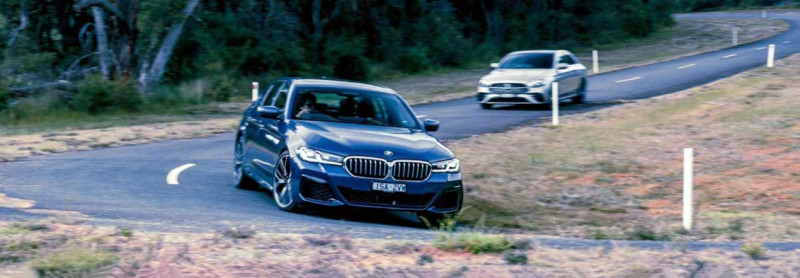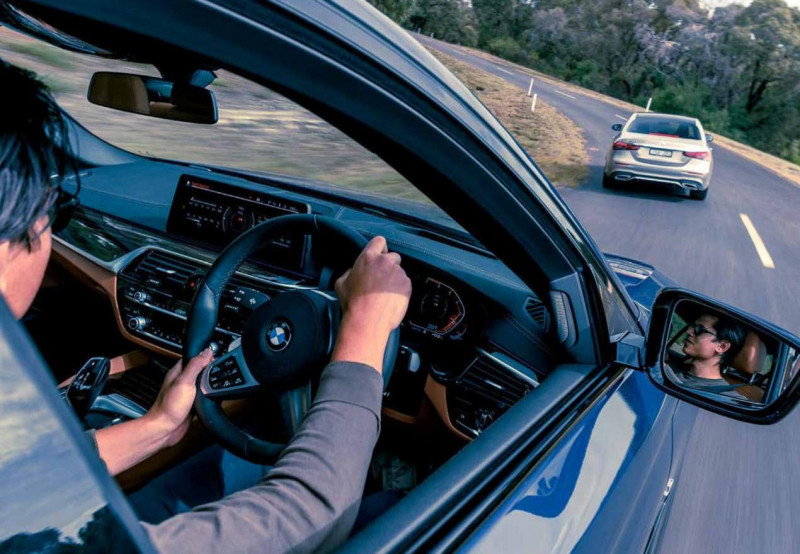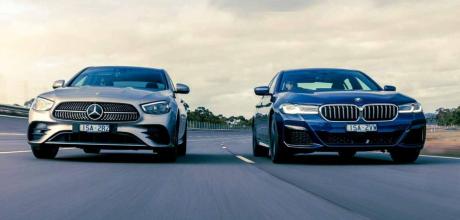2022 BMW 530i G30 v 2022 Mercedes-Benz E300 W213
They are to Germany what the commodore and falcon were to Aussies: large rear-drive sedans that once dominated the market before SUVs ruled the world. So is there still a place for this pair?
WURST AMONG EQUALS
2022 BMW 530i G30 v 2022 MERCEDES-BENZ E300 W213
Germany’s heartland sedans face off at the place that made Commodores great

When a speed sign at the Lang Lang proving ground bumps the limit up to 120km/h, a thought pops into my mind. What happens to a wallaby when you hit one at highway speeds?
This place is full of them. Kilometres of security fencing that cage in hectares of undisturbed bushland have fostered a wildlife sanctuary for the wallabies. Now, mobs of them lurk by the roadside, threatening to jump out at the slightest spook. I proceed carefully.
Given the history of this place, I also wonder what the wallabies think of our BMW 530i G30 and Mercedes-Benz E300 W213. Our duo’s understated class might look out of place among the rugged and overgrown fields of Lang Lang – but their size and layout would be familiar.

The irony of being here to test large rear-drive four-door sedans that are bitter rivals, only from another country, is not lost on me. But if there was any place to assess which of these two is better, it would be in the wheel tracks of the greats we once produced.
Holden spent decades crafting the Commodore here. Of course, the keys to these grounds now belong to Vinfast, who rented us the facility for an unrelated test. I’ve just brought these two along for a chance to wring their necks legally and in relative safety.
And while this might be a battle of the niche – large SUV sales now outstrip those of large sedans at about 24 to one – the 5 Series and E-Class are segment icons. They account for over half of large sedans sold for over $70K.

For decades the BMW 5 Series and Mercedes-Benz E-Class have infused sporting pedigree with stately comfort to plug the gap between the compact class and full-blown luxury, but recent facelifts for both set the stage for this showdown.
They have welcomed new technologies, freshly skinned front-ends and boosted specification with more kit. For instance, the E-Class kicks things off with new full-LED headlights that flank a new front bumper while the rear LED tail-lights are now split across the rear boot. E300s also score multi-beam LEDs as standard over a base E200, complete with adaptive functionality.
Inside, the E-Class interior continues to champion smooth, rounded surfaces. For example, the MBUX-capable infotainment flattens the centre console area by replacing the old bulky rotary dial with a sleeker trackpad. The pad improves the interface experience with the centre screen, but it can prove tricky to finesse at times.
The steering wheel is the same deal. For the E-Class, all steering wheels now use capacitive touchpads for functions like cruise control, media, phone calls and infotainment. While the steering wheel has its flaws, it helps the front workstation now feel and look high-tech when combined with the dual-widescreen cockpit.
The BMW 530i G30, by comparison, seems a little stale inside. In its defence, the digital instrument panel is relatively new, and the central display screen now measures 12.3 inches instead of 10.2. But most components, button pads, dials and controls are carried over. Still, if it isn’t broken – ergonomically, the BMW is still a benchmark.
Both cars offer excellent heated front seats with driving positions that make the most of their rear-drive layout and longitudinal engine placement. In the back, the BMW wins on headroom but suffers for legroom, even though it has a longer wheelbase.
Otherwise, the BMW displays its facelift proudly. Thinner front headlights match a more aggressive front bumper. There are also more geometric-shaped front kidney grilles and L-shaped daytime running lights. The rear bumper, meanwhile, features a different coloured insert.
Further changes are also hidden away under the bonnet. Four-cylinder models have upgraded fuel pressures in their direct injection systems from 2900 to 5076psi to improve throttle response and fuel efficiency.
Both cars use a 2.0-litre in-line four-cylinder force-fed by a twin-scroll turbocharger making modest yet adequate power. The BMW feeds 185kW/350Nm to the rear wheels through an eight-speed ZF transmission, whereas the Mercedes-Benz ekes out 190kW/370Nm, with a nine-speed automatic transmission and rear drive.
Despite being down one gear and lacking 5kW and 20Nm on the Mercedes, the BMW boasts a higher power-to-weight ratio thanks to a 1625kg kerb figure. But winning the battle on paper is one thing.
I start the BMW on a short makeshift drag strip, switch off ESC, engage Sport mode and dial up the torque converter to max stall. At 2500rpm, the rear 275mm-wide tyres have things under control. Once unleashed, the 530i launches without fuss, pulling hard in each gear all the way up to 6750rpm. Next, I try the Mercedes. It requires a similar launch procedure to the BMW. The nine-speed automatic builds up to about 2500rpm and punches harder in the mid-range once away. And while the E300 runs out of puff towards its topend, the transmission counteracts this with an early upshift at 6000rpm.
In the end, with more gears and higher outputs, the Mercedes registers a 6.2sec sprint to 100km/h from rest and matches its factory claim, besting the BMW by 0.2sec, which needs 6.4sec to complete the same feat and lags three tenths behind its own claimed time. Clearly, the Mercedes- Benz is a little punchier.
The tables turn when we test both cars’ braking distance from 100km/h. BMW has upgraded the 5 Series with red M Sport front brakes that look like performance calipers with a sliding design. On closer inspection, though, they have been hollowed out on either side of the fixed piston chambers to, presumably, save weight. But all that matters is they work.
Stomping on the left pedal from 100km/h pitches the BMW hard on to its nose, pressing its tyres into the tarmac for maximum bite. The Driftbox says it takes 36.4m to haul up. The Mercedes, meanwhile, needs an extra metre to arrest itself from the same speed, finishing at 37.5m.
Mercedes-Benz equips the E300 with fixed four-piston front calipers that use the Pirelli P Zero rubber wrapped around its 20-inch wheels to good effect. Its quoted weight of 1680kg is 55kg heavier than the BMW, which likely contributes.
With straight-line performance testing wrapped, our pair head to the wallaby-infested handling circuit, where I suspect the extra weight of the Mercedes might again prove a hindrance. But the Mercedes is promising at first. Sharp, direct electric steering and a short front overhang give you tighter command over its initial direction into a corner.
The BMW, meanwhile, feels less tied down. The softer adaptive suspension damping and the taller roofline equal a touch more bodyroll when you tip in, while the steering feels typically vague.
But as I push on, raising the commitment, the composure behind the Mercedes starts to unravel. The air suspension not only floats over mid-corner bumps, but the longitudinal weight transfer is way too soft for the amount of roll stiffness. In the end, the Mercedes feels awkward when making a transition from braking to cornering when really pushed.
In contrast, the BMW gets better as you push through its initial vagueness and start to trust the excellent chassis balance on offer. Admittedly, its Goodyear rubber prevents cornering speeds from getting anywhere near the talent of its chassis, but you can commit much harder in the BMW and place it with confidence.
The BMW is a sweeter steer and not only because of its chassis. The ZF eight-speed transmission shifts smoothly and will accept commands across a broad range of situations. For instance, it drops into second gear on a steep decline, as the engine speed flares to 6000rpm, without any hesitation. Whereas the Mercedes’ nine-speed transmission will lurch ever so slightly during the same test.
However, when it comes to ride comfort, our pair is more evenly matched. The Mercedes does boast slightly softer primary damping. Both, however, pay the price for 20-inch wheels. Any harsh bumps or irregularities on the road are transferred into either cabin, with the run-flat tyres on both cars adding extra bite.
Run-flats are standard across the 5 Series range. Even our particular 530i has an Enhancement Package that fits them to one-inch larger 20-inch wheels. This pack also adds Phytonic Blue metallic paint, an electric glass sunroof and BMW laser technology headlights for $5900. With a remote engine start function (costing $690) and drive recorder ($390), our tester comes in at $126,880 before on-roads.
The Mercedes-Benz E300, meanwhile, comes with two equipment packages. The first is a Vision package that adds a panoramic sunroof, head-up display and a Burmester surround-sound system (for $6600). An Innovation Package (at $1300) also ticks the box for MBUX interior assistant and MBUX augmented reality for our E300, bringing the price to $125,800. The Mojave silver metallic paint and 20-inch wheels are standard.
The onslaught of equipment continues in the safety realm. Both pack a full suite of active safety systems as standard, including adaptive cruise control, lane-keep assist and warning, blind-spot warning, stop and go assist, surround camera views and cross-traffic alert. And while the BMW features a head-up display as standard, the Mercedes packs nine airbags to trump the seven in the BMW.
And what about recurring costs? The 530i claims a handy on-paper fuel consumption advantage (6.2L/100km versus the Merc’s 8.2L/100km); in the real world the difference is likely to be less significant.
Servicing-wise, BMW offers a fixed-price plan on standard servicing over five years for $2800. The Mercedes- Benz equivalent costs $4800, but the BMW package covers distances travelled up to 80,000km, whereas Mercedes-Benz covers up to 125,000km.
When it comes time to sell, expect manufacturer warranty to influence residual values. And in that case, a transferable Mercedes-Benz five-year unlimited-kilometre warranty on the E300 will look more attractive to secondhand buyers in a handful of years, whereas the prospect of a BMW near the end of its three-year unlimited-kilometre warranty might seem less so.
Yet, as for naming a winner, it’s perhaps no surprise to learn that it’s hard to pick one. Both manufacturers have kept a close eye on each other for such a long time that no matter which you choose, you’re getting quite similar machines – a thoroughly refined sedan with style, impressive engineering and leading technology.
But if you’re brand agnostic and need to boil it all down, you can see the Mercedes-Benz E300 offers strong performance, an attractive price and warranty package, loads of technology and a fresher cockpit. The BMW 530i, meanwhile, drives with an engagement and deftness that reflects its edgier overall character.
For these reasons, our equal ratings underscore how evenly this washes out. But if pushed, I’d say you buy the Mercedes-Benz with your head and the BMW with your heart. And given the wallabies of Lang Lang forced us to side with our heads already once today, it’s only fitting we live a little and side with the BMW. It wins, but only just.
As for naming a winner, it’s perhaps no surprise to learn that it’s hard to pick one
Above: variations on a theme. In common; four cylinders, 2.0-litre capacity, single turbo. Merc’s unit (top) is slightly stronger (up 5kW and 20Nm over the BMW) but drinks a little more on the official cycle
The irony of being here to test large rear-drive four-door sedans that are bitter rivals, only from another country, is not lost on me
STEP UP Add more herbs
YOUR CHOICES WHEN YOU WANT MORE THAN FOUR
Take a close look at the engine outputs of this pair, then look elsewhere in the respective BMW and M-B ranges, and you’ll see an inescapable fact: both are sandbagging.
Meaning, both these engines are offered in higher states of tune involving little more than a different ECU code. The basis of the 2.0-litre four in the 530i, when fitted to the high-po 1 and 2 Series, for example, makes a far more robust 225/450Nm. Australia doesn’t get the 540i with six-pot petrol power, so unless you go diesel, the ballsier 5 is the G30 M550i xDrive with twin-turbo V8. As for the Merc? Well, just after we completed this test, M-B Australia advised it was dropping the E300, effectively replacing it with the E350, which is around $11K more expensive, but turns the wick on the four-pot up to 220kW/400Nm, assisted by a mild-hybrid system that can boost that by 10kW/150Nm
INNER FOCUS
2022 Benz E300 W213
The new Mercedes- Benz steering wheel looks slick, but we have a few gripes. Not only do the wheel’s controls look confusing, with a uniform symbol colour making it hard to discern buttons at a glance, the volume pad no longer offers mechanical feedback, so you can overshoot your desired volume setting. The MBUX Interior Assistant function, part of an optional package, can be handy. A front-mounted camera detects hand gestures and responds with either highlighted tiles on the infotainment or switching on the passenger reading light when you’re reaching across.
2022 BMW 530i G30 LCI
The BMW cabin is well kitted out with wireless smartphone charging and connectivity, along with a Harman/Kardon speaker system rated at 464 watts. We experienced several drop-outs with our iPhone and CarPlay, which is frustrating as even the latest iDrive 7 software cannot match the Apple software for intuitiveness. That said, the larger centre screen is responsive and crystal clear.
The ‘Dakota’ Cognac coloured leather split opinion among testers, as did the fine-wood trim on the inserts with pearl chrome finishing.
Above right: The 530i reveals itself as the car for keen drivers, once you push through the slightly inert steering. The E300 (below) is happier at about seven-tenths, and gives a bit more cruising comfort thanks to its softer overall chassis tune
2022 BMW 530i G30 $119,900 /Tested $126,880* MERCEDES-BENZ E300 $117,900/Tested $125,800*
Drivetrain
- Engine 4cyl, dohc, 16v, turbo / 4cyl, dohc, 16v, turbo
- Layout Front engine (north-south), rear drive / Front engine (north-south), rear drive
- Capacity 1998cc / 1991cc
- Max Power 185kW @ 5300-6500rpm / 190kW @ 5800-6000rpm
- Max Torque 350Nm @ 1450-4800rpm / 370Nm @ 1800-4000rpm
- Gearbox 8-speed automatic / 9-speed automatic
Chassis
- Body 4-door, 5-seat sedan / 4-door, 5-seat sedan
- L/W/H/W–B 4963/1868/1479mm / 4955/1860/1455mm
- Track (F/R) 1605/1630mm / 1601/1595mm
- Weight 1625kg / 1680kg
- Boot 530L / 540L
- Fuel/tank Petrol/78 litres / Petrol/80 litres
- Economy 6.2L/100km (ADR combined cycle) / 8.0L/100km (ADR combined cycle)
- Suspension Double A-arms, adaptive dampers, anti-roll bar (f); multi-links, adaptive dampers, anti-roll bar ® / Double A-arms, adaptive air dampers, anti-roll bar (f); Multi-links, adaptive air dampers, anti-roll bar
- Steering electric rack-and-pinion
- Front brakes 355mm ventilated discs / 345mm ventilated discs
- Rear brakes 305mm ventilated discs / 300mm ventilated discs
- Tyres Goodyear Eagle F1 / Pirelli P Zero
- Tyre size 245/35 R20 (f); 275/30 R20 ® / 245/35 R20 (f); 275/30 R20 ®
Safety
- ANCAP rating 5 stars / 5 stars
- Performance
- 062mph (0-100km/h) 6.4sec / 6.2sec
- 100km/h-0 36.4m / 37.5m
- Verdict 8.0/10 / 8.0/10
BMW* Includes Enhancement Package (20-inch wheels, metallic paint, sunroof and laser headlights; $5900); remote engine start function ($690); drive recorder ($390)
BENZ* Includes Vision package (panoramic sunroof, head-up display, Burmester surround-sound system; $6600); Innovation package (MBUX interior assistant and MBUX augmented reality; $1300)


